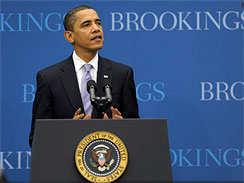A closer look at Obama's jobs plan: Will it work?
 President Obama just wrapped up his much-anticipated "jobs speech," an attempt to show the administration has a plan to confront the harsh reality that, despite slight job gains last month, 10% of the U.S. workforce remains unemployed.The speech and proposal were classic Obama: Sweepingly eloquent in vision and thoroughly practical and moderate in the details. Our breakdown of the key pieces:
President Obama just wrapped up his much-anticipated "jobs speech," an attempt to show the administration has a plan to confront the harsh reality that, despite slight job gains last month, 10% of the U.S. workforce remains unemployed.The speech and proposal were classic Obama: Sweepingly eloquent in vision and thoroughly practical and moderate in the details. Our breakdown of the key pieces:BOOST SMALL BUSINESS: The bulk of Obama's plan focuses on the politically popular idea of helping small businesses. Obama proposes a one-year elimination of capital gains taxes for small firms, a depreciation tax incentive, and eliminating fees and increasing guarantees through the Small Business Administration.
If this sounds like a version of "trickle down" economics -- give money to companies and hope they use it to hire people -- it is. The danger in such an indirect approach, of course, is that financially-strapped small firms may just pocket the savings (at least in the short term) rather than invest in new workers.
Only one plank of Obama's small business plan relates directly to job creation: a job-creation tax credit for small business. But limiting the credit to small firms goes against the advice of experts like those at the Economic Policy Institute, who believe that an effective jobs credit "should be designed to stimulate a wide range of jobs across economicsectors and across all kinds of firms, regardless of size or currentprofitability."
INFRASTRUCTURE JOBS: The part of Obama's plan to "continue modernizing our transportation and communications networks" was sketchier on details.
One thing Obama did seem to rule out was the idea of creating public-sector jobs, like Roosevelt's New Deal programs. In the speech, Obama referred to infrastructure jobs as "needed public works that engage private sector companies, spurring hiring across the country" [emphasis added].
Economists like Paul Krugman have pushed for a new WPA-like program that directly creates public service jobs, estimating that $40 billion over three years would create about 1 million jobs for needed public works projects.
In our upcoming issue of Southern Exposure looking at "A New New Deal in the South?" (join here to get a copy!), we feature a piece by Scott Myers-Lipton that looks at the excellent track record of FDR's much-maligned New Deal public works programs. Here's a sneak preview:
The WPA produced results: In its eight-year history, the Works Progress Administration spent about $10.8 billion (about $165 billion in 2008 dollars), employed 8.5 million people, and worked on 1.4 million projects. The WPA built or improved 103 golf courses, 853 airport landing fields, 2,500 hospitals, 2,500 sports stadiums, 3,000 schools, 8,192 parks, 12,800 playgrounds, 124,031 bridges, 125,110 public buildings, and 651,087 miles of highways and roads.Most importantly, Meyers-Lipton points out that the successful WPA was in part a response to the Public Works Administration, FDR's first jobs program which depended on private contractors -- and was abandoned because it didn't create jobs fast enough.
GREEN JOBS: Another good idea, although also without as much detail as the small business portion. (My colleague Sue Sturgis will be writing more about this later). Obama's plan focuses on (1) credits for consumers who make "energy efficiency retrofits" on their homes, and (2) expanding programs in the original stimulus bill for green job projects.
Obama also added a paragraph about supporting and expanding the safety net -- unemployment insurance, COBRA -- and fiscal relief to states: important, but underdeveloped in his proposal. The rest of the speech focused on TARP and health care reform, which of course are critical elements of economic recovery but less directly related to jobs.
The overall takeaway? It's a modest plan aimed at pleasing the political center, and it's only a broad outline about how to address the unemployment crisis. Is that enough?
Tags
Chris Kromm
Chris Kromm is executive director of the Institute for Southern Studies and publisher of the Institute's online magazine, Facing South.
